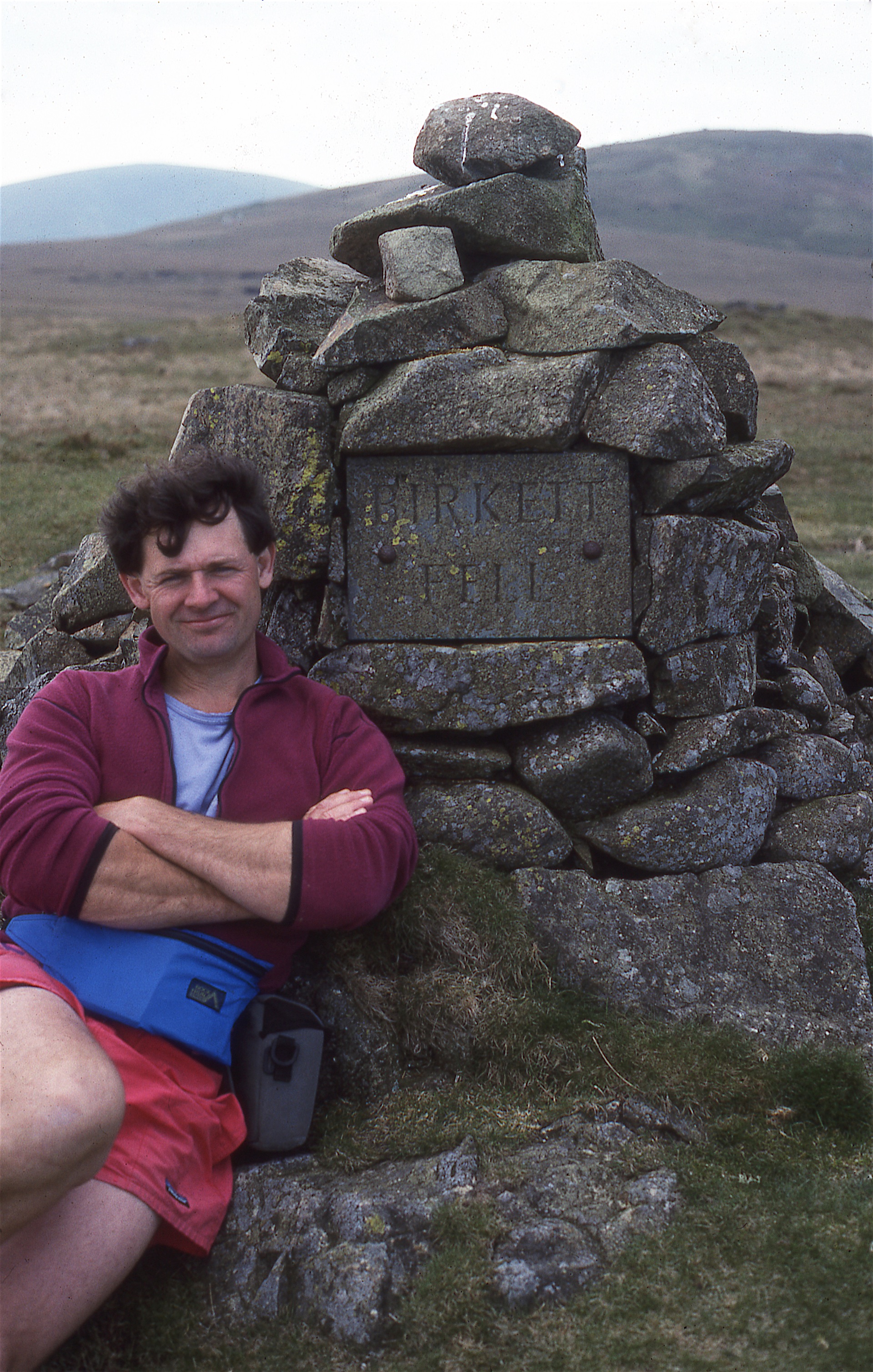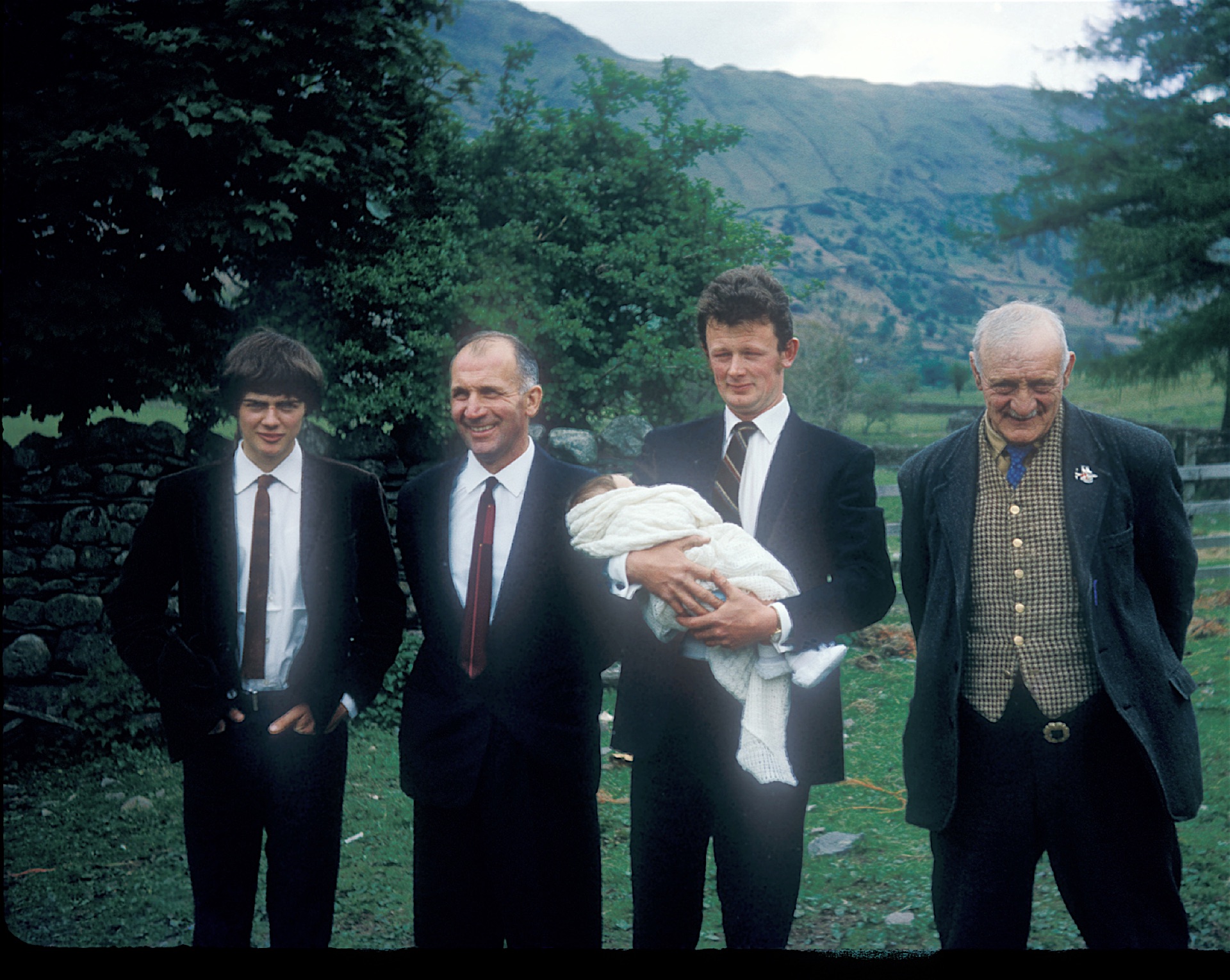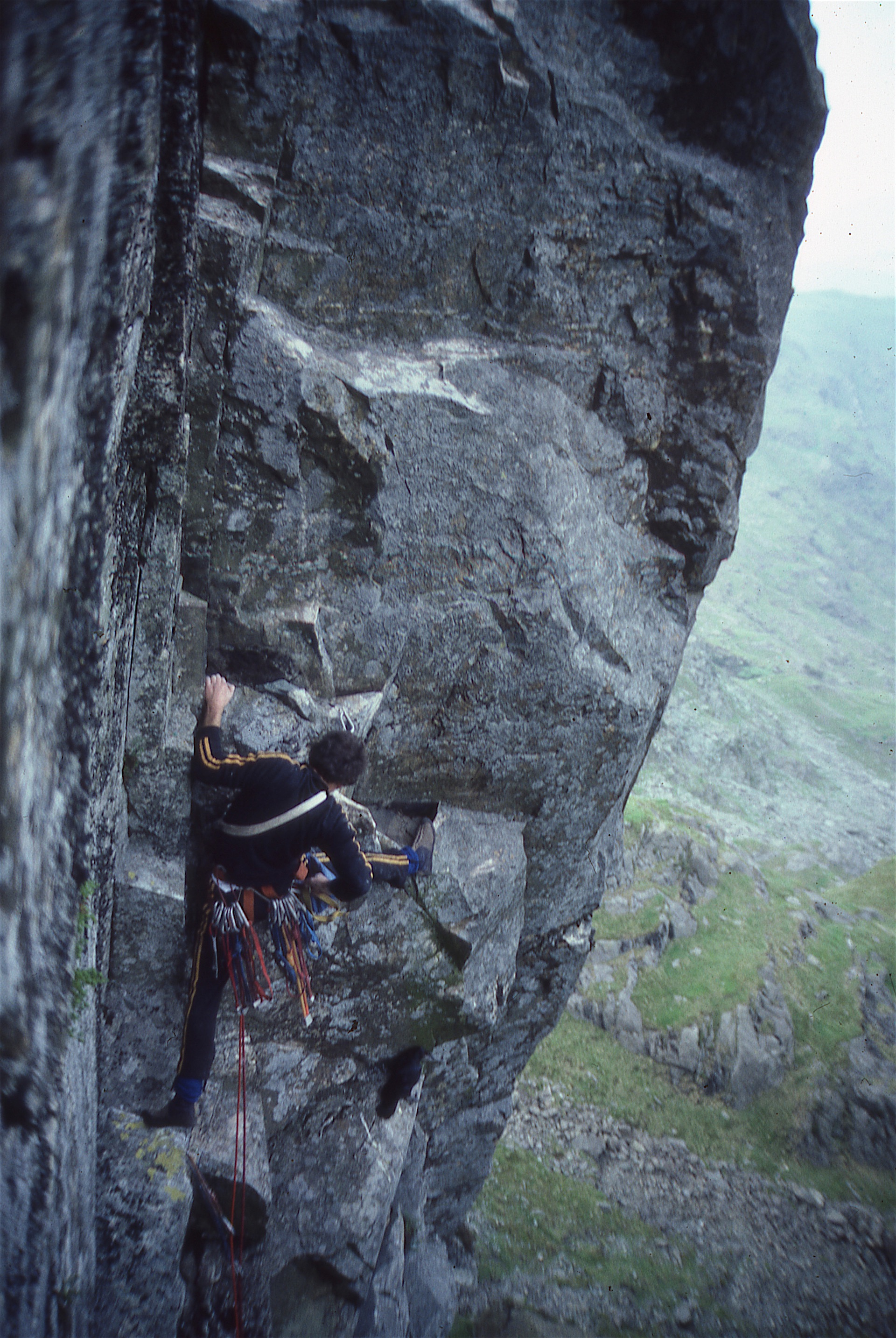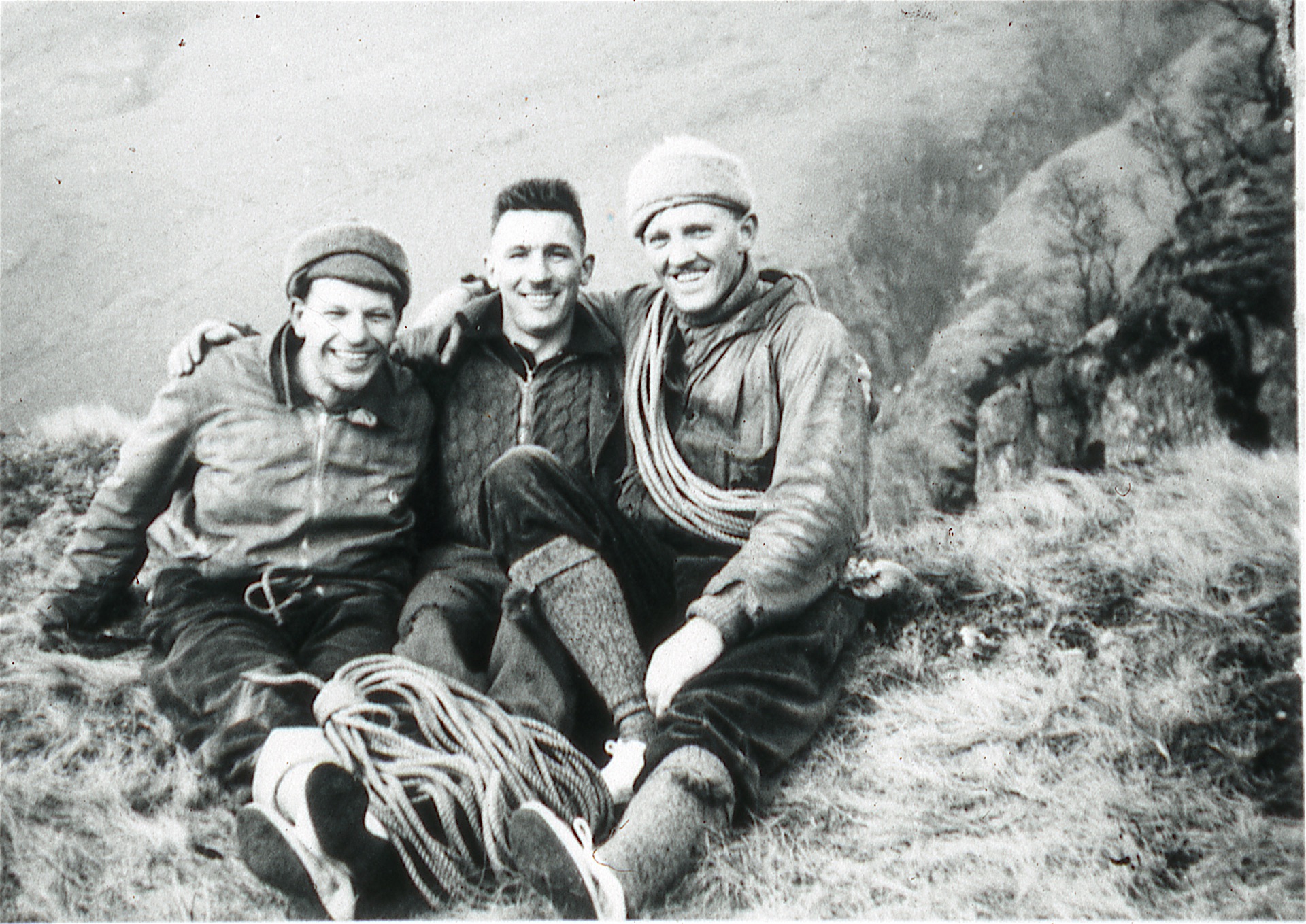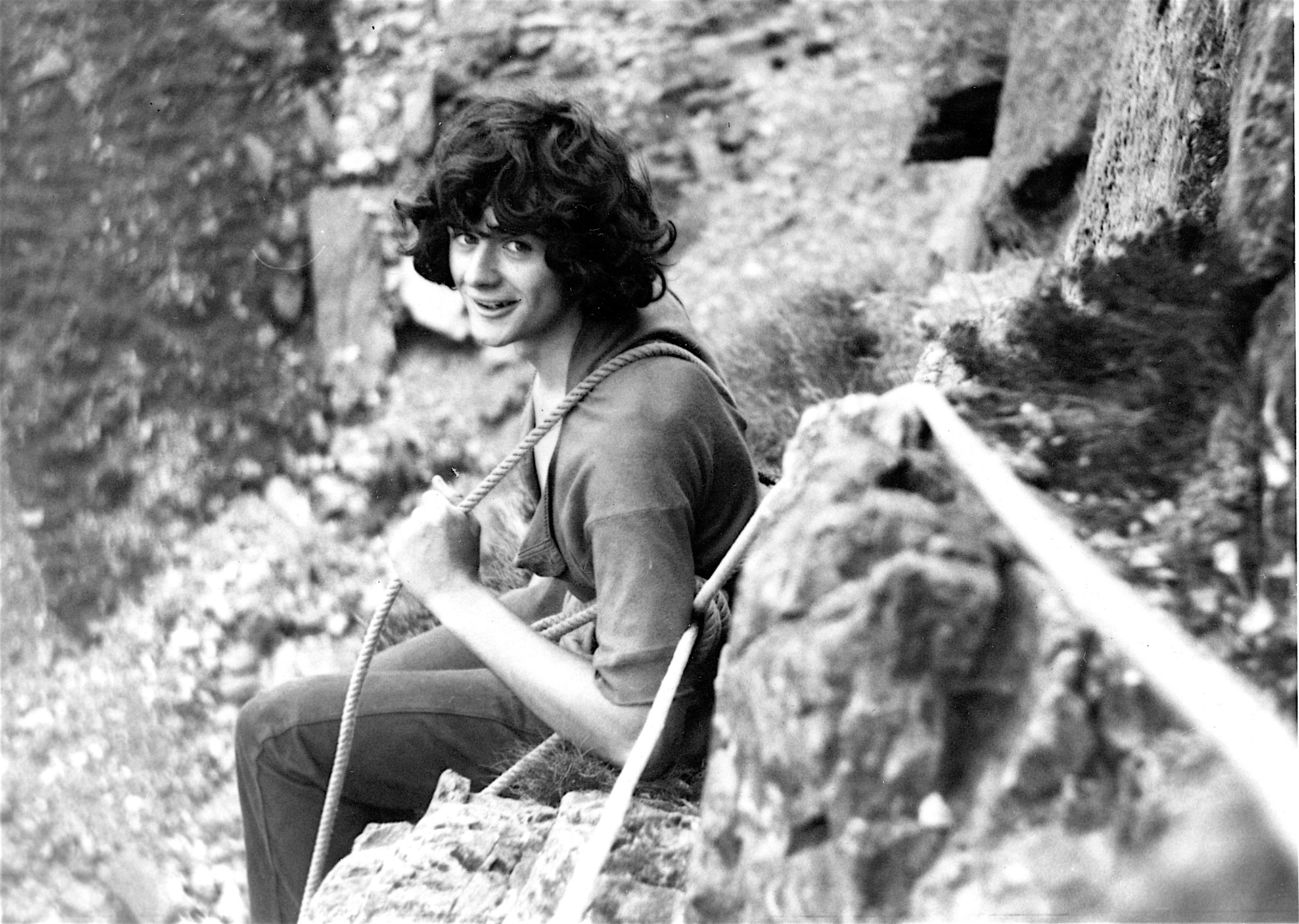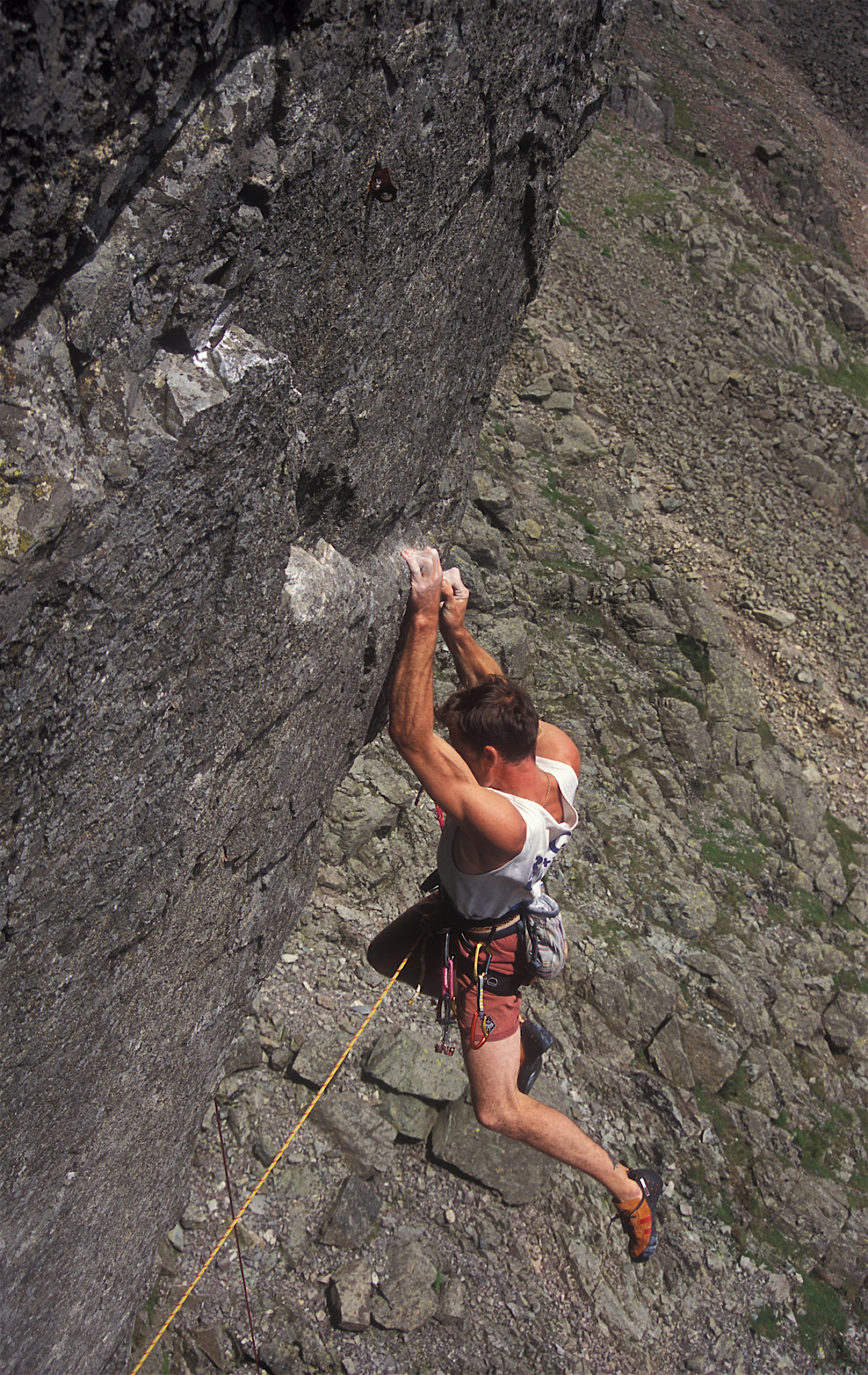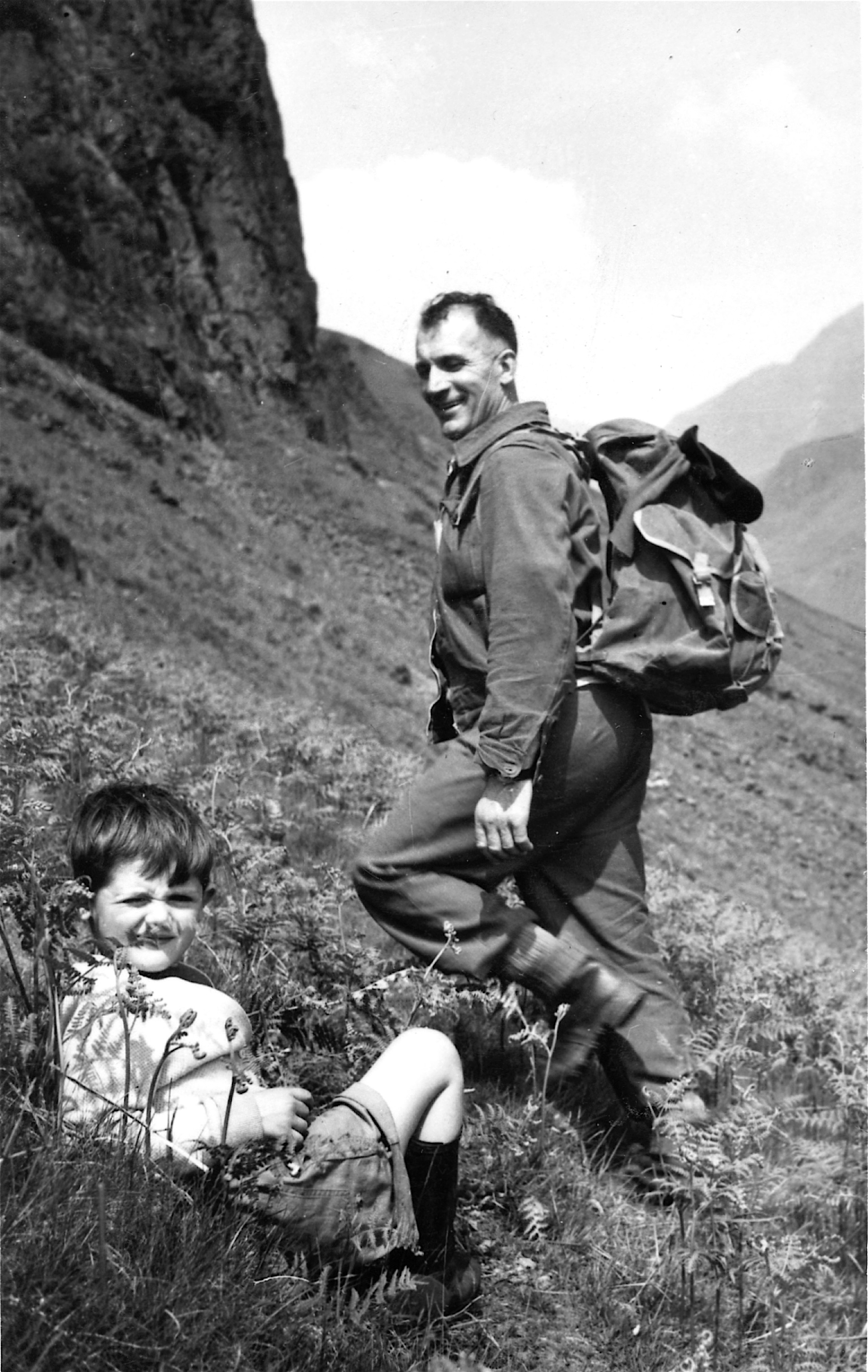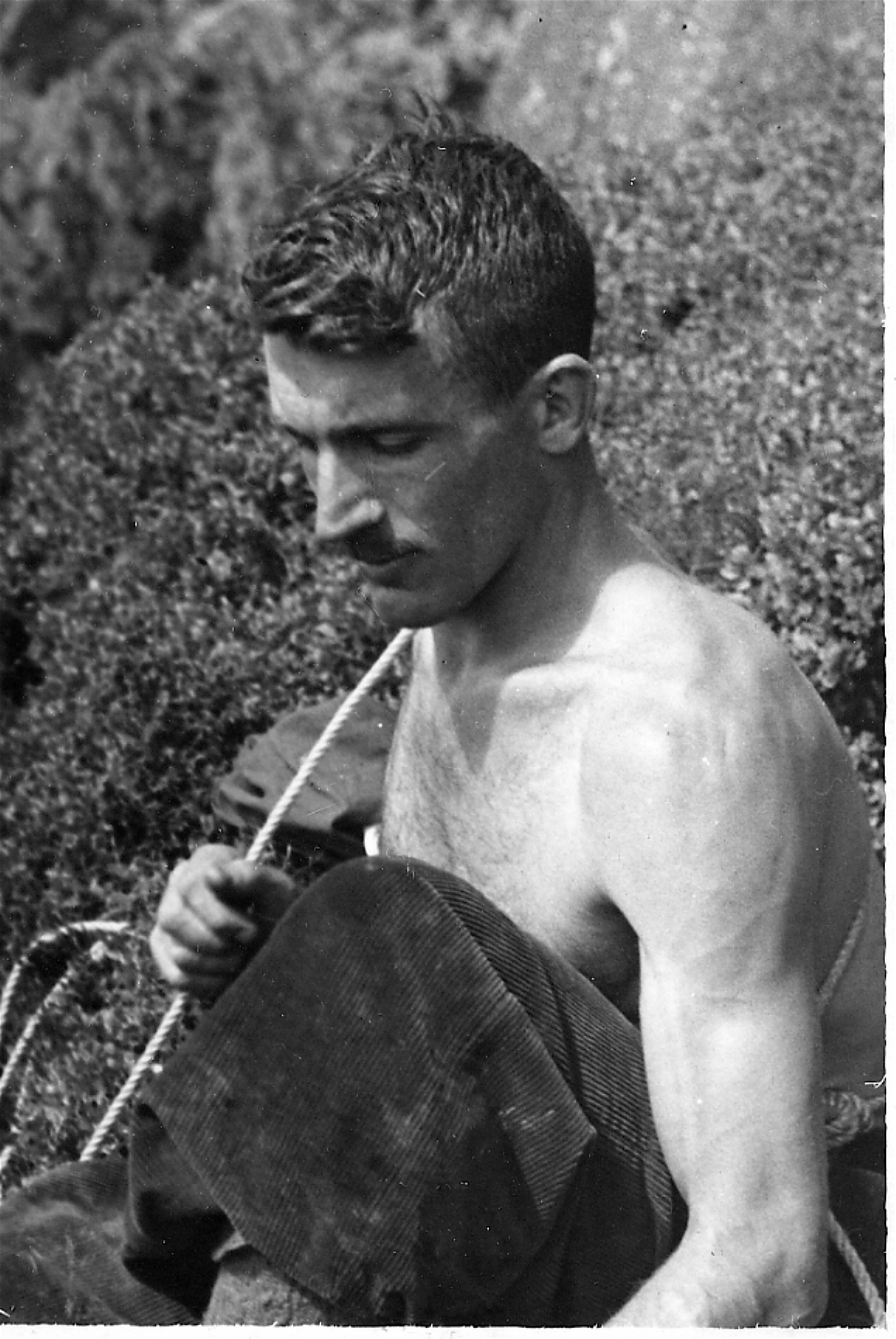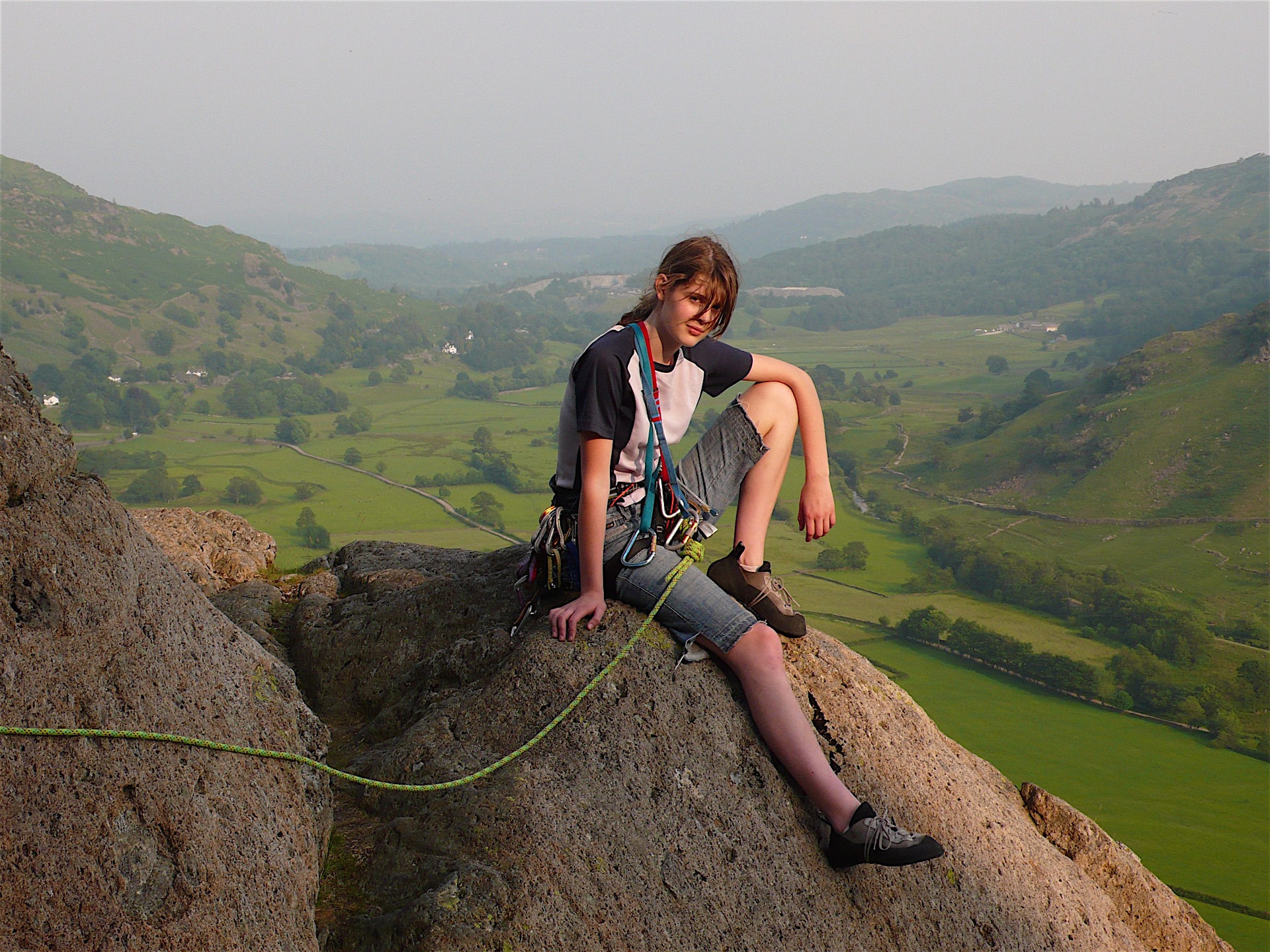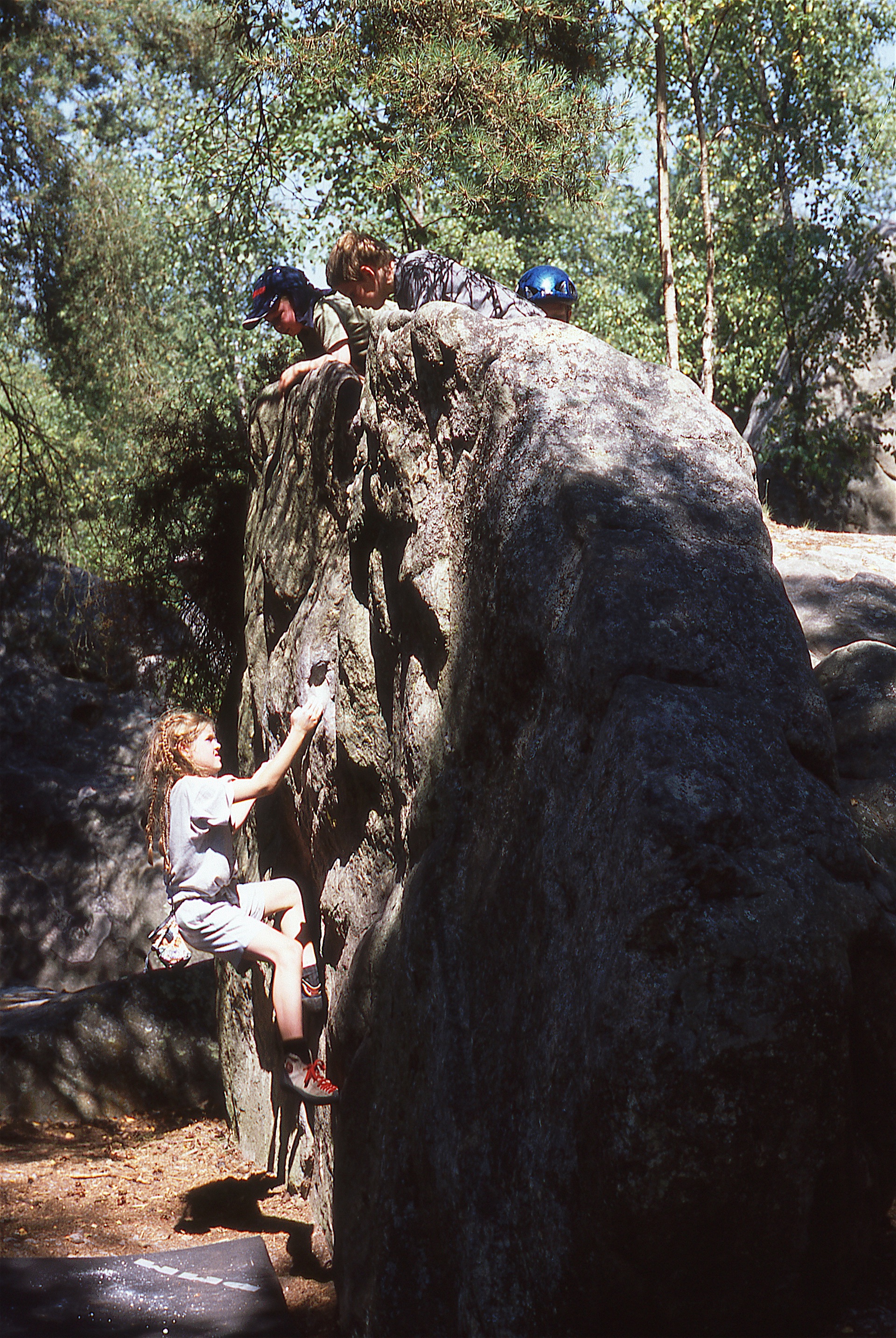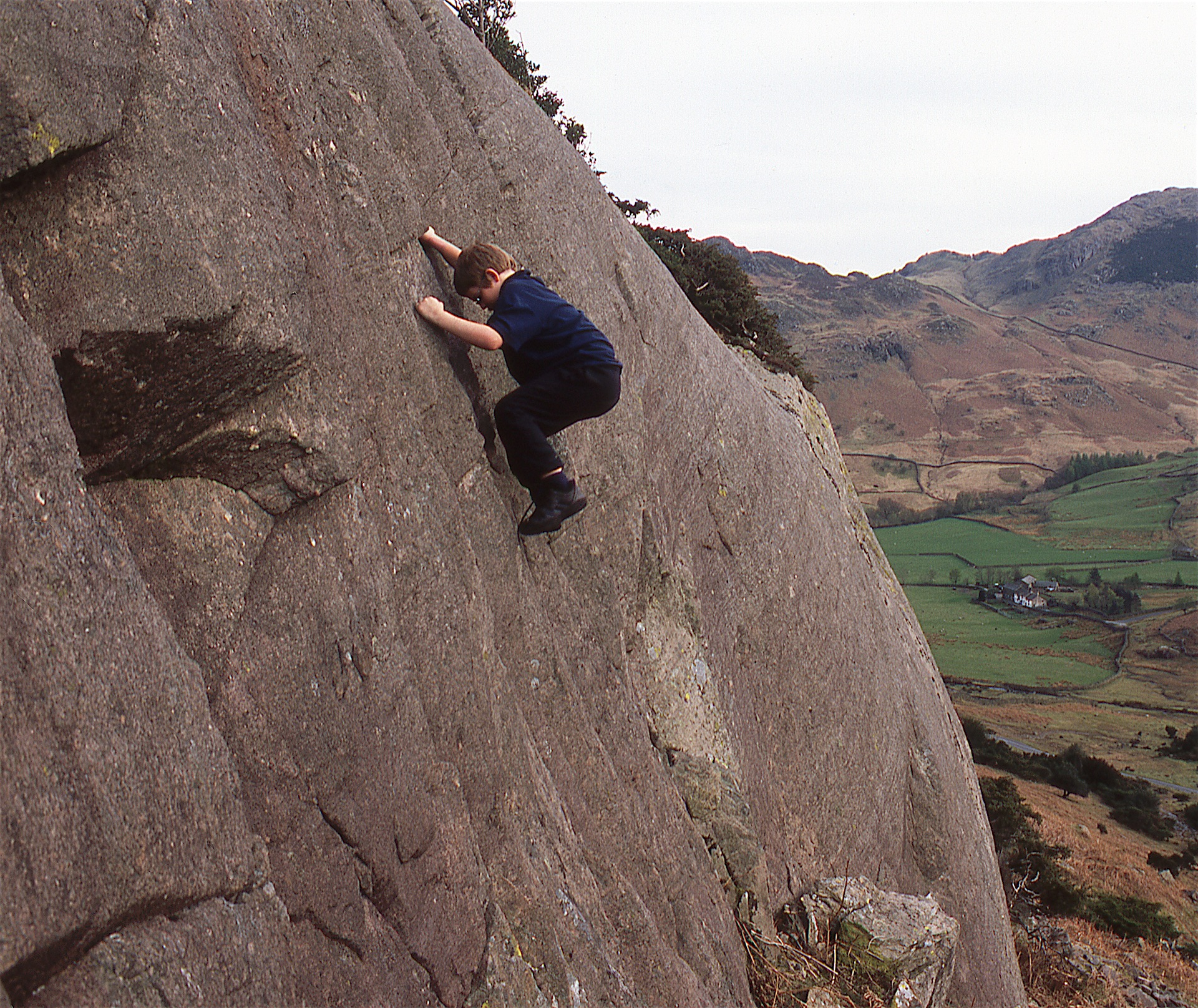Bill Birkett on Birkett Fell circa 1993 whilst working on the classic ‘COMPLETE LAKELAND FELLS’, the only single book that details ALL the Lakeland Fells over 1,000ft in altitude, first published by Collins Willow in 1994.
Some Birkett’s at Side House Farm for Dave’s christening day in 1968. From left to right: Bill (me) , Jim (my father and Dave’s grandfather), Leonard (Dave’s Dad), holding Dave in his arms and Tommy Birkett (my grandfather). Note Tommy’s ‘Alpine Club’ lapel badge. He used to tell all the ‘vistors’ in the Three Shires Inn in Little Langdale that he had been on the 1st ascent of the Matterhorn. Always worth a free pint!
My pic of Dave Birkett making the first ascent of ‘Nowt But A Flee’in Thing’ on Cam Crag above Wastwater. Despite pale imitations (Dave repeated the route for Alastair Lee’s brilliant documentary film ‘Set In Stone’) this is the THE first ascent in May 2005 shot just has the drama unfolded. Breathtaking. Doug Scott (THE famous British big mountain climber) told me directly (and I have witnesses) that he thought that this is the best rock climbing photograph he’s ever seen. Wow, that made me feel very special as a photographer even though I’ll never climb the route now. Limited edition prints of this image are available from the shop.
This is me on a boulder below Deer Bield Crag located above the valley of Easedale in the Lake District. It’s taken from the insert on the back cover of my guidebook ‘French rock’ which was published by Cicerone Press in 1993. The book served as a general pictorial guide to show something of the variety of ‘sport’ rock climbing then available across France.
This is me (Bill) on the first ascent of Asolo E3 6a on the North Buttress of Dove Crag in May 1981. The name caused controversy because it was chosen deliberately to advertise the Italian boot manufacturer and was the first attempt to obtain sponsorship for rock climbers. Today sponsorship for top rock climbers is now de rigueur.
Jim Birkett, centre, with Len Muscroft, left, and Charlie Wilson, right, on top after their first ascent of Overhanging Bastion up the North Face of Castle Rock. It’s now graded HVS 5a and at the time the climb caused a sensation because it was much bolder and harder than any other rock climb in Britain. The headlines in the press read ‘Lakeland Everest Conquered’. It’s still a considerable undertaking even with today’s modern equipment and footwear.
Jim Birkett climbing in his trusty nailed boots on Kern Knotts, Great Gable, circa early 1940’s. His second is Charlie Wilson and he’s belaying Jim so the live hemp rope runs over one shoulder and around his waist and at Jim’s end it’s tied with a bowline knot loosely around his midriff. What could possibly go wrong! Jim was always reckoned to be the finest ever exponent of nailed boot climbing. He used ‘waisted clinkers’ and he could seemingly stand effortlessly on tiny ruggosites in the rock. Of course immense finger and arm strength and not a little technique helped this illusion of being able to stand on virtually nothing. The rule in those days was simply that the leader should never fall. Jim believed firmly that rules were not to be broken – his rules you understand.
Bouldering on the sandstone of St Bees sea cliffs January 2016. From L to R, Bill, Dave holding May and Will Birkett. Photo by Mary Jenner – Birkett (May’s Mum and a great climber in her own right).
Will Birkett leading Trevallen Pillar E4 6a, Pembroke sea cliffs, August 2016. A touchstone route of it’s grade.
The Tete du Chien (Head of the Dog) is the most famous boulder at Fontainebleau. The Forest of Fontainebleau, to the south east of Paris, is the most famous bouldering area in the world and it’s perfect for family climbing. This is me with my son Will, left, and daughter Ro, right, in August 2005. It’s a bit too hot at this time of year for serious climbing but for a fun time why not? Both these two started out as tiny tots on the ‘white’ children’s circuits and worked their way upwards as they aged. Hope we will still be climbing here together in 2025.
Bill Birkett belaying in White Ghyll circa 1967, I’ve just lead Jim Birkett’s hardest route in White Ghyll – ‘Perhaps Not’. Jim first lead this route with Len Muscroft on 15th May 1949. Today it’s graded HVS (5a) and the guidebook states: “Faith in what may be above is required when the holds disappear.” The main problem in 1949 was the lack of protection and Jim lead the crux on sight with Len belayed to a tiny sapling, long gone, at the end of the exposed traverse beneath the overhangs. Committing and serious climbing at the top of the technical grade of the day. Come to think of it there wasn’t much protection, or perhaps any, in 1967 when I climbed it but by then 5a wasn’t anyway near the top technical grade and Dad had told me better holds lay above! And, let’s face it, climbing seemed so easy when I was 15.
Dave Birkett leading ‘Talbot Horizon’ his 27th July 2000 route graded E9 6c on the East Buttress of Scafell. At that time it was probably the hardest ‘traditional’ route in Britain (and in fact the World). Even with modern protection this spectacular and difficult route remains a very serious undertaking and it didn’t get a second ascent until 2016. I was hanging free on a rope to take this photograph and although I have absolute confidence in Dave, he’s one of only three climbers I would trust with my life, I felt the enormity of the situation and was more than a little gripped.
This is the famous Napes Needle on Great Gable circa late 1930’s. Jim Birkett is silhouetted on the arête climbing in nailed boots. The other climbers are (I think): Len Muscroft (top), Charlie Wilson (left) and John Craven (bottom).
Bill Birkett and Dave Birkett on top of Castle Rock after making the 50th Anniversary ascent of Overhanging Bastion on 1st April 1987. OB is Jim Birkett’s great classic route of the 1930’s and was a breakthrough in both concept and difficulty. This was the first time we climbed together and Dave Birkett hadn’t been climbing for very long. Afterwards he lead me up the much harder route called Ted Cheasby E3 5c and I knew a new star was rising.
Me and Dad (Jim Birkett) heading for Heron Crag in Upper Eskdale sometime around the late 1950’s to look at the Golden Eagle’s nest which was in use before rock climbers discovered the crag. Happy, carefree days when the mountains were much quieter and despite my tender age most weekend days were spent on the hills.
Jim Birkett belaying above Gimmer Crag, Great Langdale circa late 1930’s. Mr cool! Basically the thin hemp ropes of those days offered little practical security. They may have been just strong enough to hold a second man’s fall but certainly wouldn’t have held a leader fall and there wasn’t any real protection in any case. The lead climber in those days had to be strong both mentally and physically.
Ro Birkett atop Scout Crag, Great Langdale, aged 15 in June 2007. She’s just lead Route 1, a really great classic route taking the exposed nose up the front face of the crag.
Bill Birkett, with two new knees, climbing on the classic Bow Shaped Slab area, Pembroke sea cliffs, summer 2015.
A very determined Ro Birkett, aged 10, on Yellow 15 at La Roche aux Sabots, Fontainebleau, Will Birkett and Josh Faux looking on. August 2012.
Will Birkett bouldering on sight on a craglet above the Blea Tarn road, Little Langdale, aged 8, May 2004. He just set off and I couldn’t stop him. There’s no bouldering mat or soft sandy landing here.

